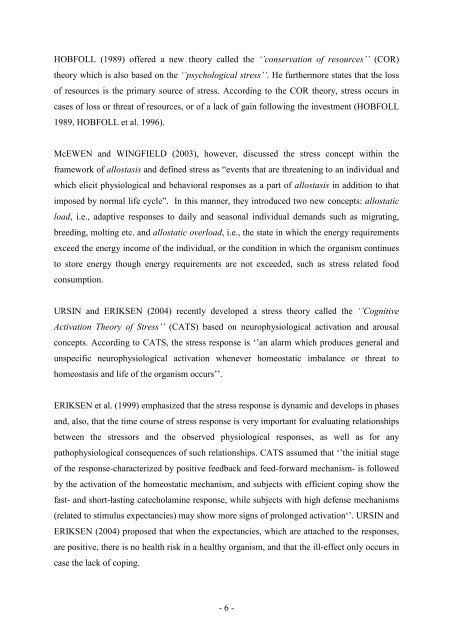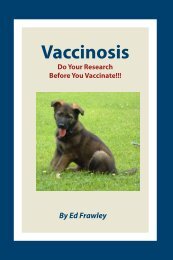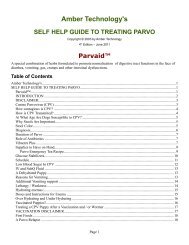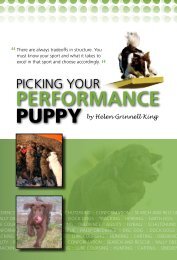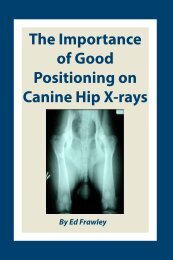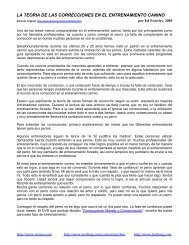Comparison of Stress and Learning Effects of Three Different ...
Comparison of Stress and Learning Effects of Three Different ...
Comparison of Stress and Learning Effects of Three Different ...
Create successful ePaper yourself
Turn your PDF publications into a flip-book with our unique Google optimized e-Paper software.
HOBFOLL (1989) <strong>of</strong>fered a new theory called the ‘’conservation <strong>of</strong> resources’’ (COR)<br />
theory which is also based on the ‘’psychological stress’’. He furthermore states that the loss<br />
<strong>of</strong> resources is the primary source <strong>of</strong> stress. According to the COR theory, stress occurs in<br />
cases <strong>of</strong> loss or threat <strong>of</strong> resources, or <strong>of</strong> a lack <strong>of</strong> gain following the investment (HOBFOLL<br />
1989, HOBFOLL et al. 1996).<br />
McEWEN <strong>and</strong> WINGFIELD (2003), however, discussed the stress concept within the<br />
framework <strong>of</strong> allostasis <strong>and</strong> defined stress as “events that are threatening to an individual <strong>and</strong><br />
which elicit physiological <strong>and</strong> behavioral responses as a part <strong>of</strong> allostasis in addition to that<br />
imposed by normal life cycle”. In this manner, they introduced two new concepts: allostatic<br />
load, i.e., adaptive responses to daily <strong>and</strong> seasonal individual dem<strong>and</strong>s such as migrating,<br />
breeding, molting etc. <strong>and</strong> allostatic overload, i.e., the state in which the energy requirements<br />
exceed the energy income <strong>of</strong> the individual, or the condition in which the organism continues<br />
to store energy though energy requirements are not exceeded, such as stress related food<br />
consumption.<br />
URSIN <strong>and</strong> ERIKSEN (2004) recently developed a stress theory called the ‘’Cognitive<br />
Activation Theory <strong>of</strong> <strong>Stress</strong>’’ (CATS) based on neurophysiological activation <strong>and</strong> arousal<br />
concepts. According to CATS, the stress response is ‘’an alarm which produces general <strong>and</strong><br />
unspecific neurophysiological activation whenever homeostatic imbalance or threat to<br />
homeostasis <strong>and</strong> life <strong>of</strong> the organism occurs’’.<br />
ERIKSEN et al. (1999) emphasized that the stress response is dynamic <strong>and</strong> develops in phases<br />
<strong>and</strong>, also, that the time course <strong>of</strong> stress response is very important for evaluating relationships<br />
between the stressors <strong>and</strong> the observed physiological responses, as well as for any<br />
pathophysiological consequences <strong>of</strong> such relationships. CATS assumed that ‘’the initial stage<br />
<strong>of</strong> the response-characterized by positive feedback <strong>and</strong> feed-forward mechanism- is followed<br />
by the activation <strong>of</strong> the homeostatic mechanism, <strong>and</strong> subjects with efficient coping show the<br />
fast- <strong>and</strong> short-lasting catecholamine response, while subjects with high defense mechanisms<br />
(related to stimulus expectancies) may show more signs <strong>of</strong> prolonged activation‘’. URSIN <strong>and</strong><br />
ERIKSEN (2004) proposed that when the expectancies, which are attached to the responses,<br />
are positive, there is no health risk in a healthy organism, <strong>and</strong> that the ill-effect only occurs in<br />
case the lack <strong>of</strong> coping.<br />
- 6 -


